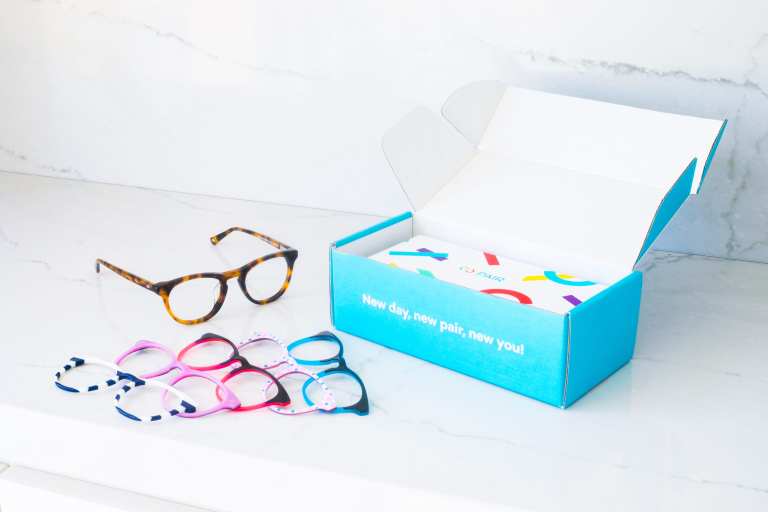Setting Sights On Children’s Customizable Eyewear

Pair Eyewear Co-Founder and CEO Nathan Kondamuri started wearing glasses when he was 8 years old, around second or third grade. He told PYMNTS in an interview that he remembers “how daunting” and uncomfortable “of an experience it was getting glasses for the first time.” It’s the first time that kids start to look different from others in their class — and, beyond that, he noted that the actual “buying process of glasses doesn’t really help the situation at all.” The experience, he said, is “very archaic” as well as medical, and it tends to feel like something for older people. Consumers have to go into a brick-and-mortar store and choose between a limited selection of options children often find boring.
Kondamuri remembers leaving the store without much enthusiasm for his glasses and not wanting to wear them. But he notes that children are excited about some of their other possessions like shoes or clothes — things they can, after all, change on a daily basis. Eyeglasses, on the other hand, have been a static medical device for hundreds of years. Kondamuri ended up meeting future Pair Eyewear Co-Founder and CEO Sophia Edelstein at Stanford University. They became best friends, and, in his senior year, he told Edelstein about his experiences with glasses because his younger brother was going through the same challenge.
Kondamuri heard from his brother that he didn’t like wearing his eyeglasses. And he also heard that the experience was difficult for his mother, who felt guilty for needing to get his little brother glasses that he didn’t enjoy wearing. It was “really expensive as well,” he said, noting she would end up spending $200 to $300 out of pocket at the store for the glasses. He and Edelstein started thinking more deeply about the challenges of children’s eyewear — why glasses hadn’t been designed for kids to be exciting and why the experience had not been fun for families. They would end up starting Pair Eyewear to help change up that experience.
The Glasses
Kondamuri and Edelstein talked to hundreds of families in their senior year by going around the Bay Area. They learned a great deal from their conversations — including the fact that Kondamuri and his brother were not alone in their experiences. They learned kids wanted to wear, say, a blue pair of glasses one day and a polka dot pair the next day. They had all these fun, creative ideas, Kondamuri said, but the glasses did not allow them to express that. That is how the company came upon the idea of continually customizable glasses that let kids change up their glasses daily via magnetic tops.
Once kids and families learn about Pair Eyewear, they can visit the company’s website where they can immediately see how the eyeglasses are customizable. They are then prompted to choose their base frames (with names like “The Twain” or the “The Cedro”) and then the top frames. The company has a page where kids see what the different colors look like and essentially build up their perfect pair. And the company also came out with sunglass tops that let kids turn their prescription glasses into prescription sunglasses.
The exciting part about a pair, Kondamuri says, is that “we’re building this relationship with families and kids,” where children are excited to come back to see the company’s new designs and styles. For eCommerce, the company uses Shopify for its website and eCommerce platform. And it accepts credit card, PayPal or Google Pay for payments. When it comes to product differentiation, the company has done many things to make its frame styles different than those that are on the market.
The Differentiators
For starters, the company designed its collection with kids in mind and had hundreds of user interviews as well as panels with children to find out what kinds of frames, styles, and colors they wanted. The frames are also very lightweight and made of hand-polished cellulose acetate with spring-loaded hinges for flexibility as well as durability for children. It also uses proprietary universally fitting nose pads. Another point of differentiation is the company’s price point: The frames start at $60, including prescription lenses. And, from the company’s research, it has found that its target market is all families with kids who wear glasses.
The company also offers a Pair for a Pair program where “for every pair of glasses you purchase, Pair will provide glasses to a child in need,” according to its website. It partners with the EYElliance to provide glasses to children in the developing world who have poor vision. Kondamuri noted that kids are not often brought into the idea of giving back until a much later age, such as high school or college. But he says the company wanted to help kids realize that their purchase can be powerful and that “they can have an impact in giving back as well.”
By charitable program or innovative eCommerce, DTC brands like Pair Eyewear are making shopping for prescription eyeglasses more enjoyable and rewarding for families with changing eyesight needs.